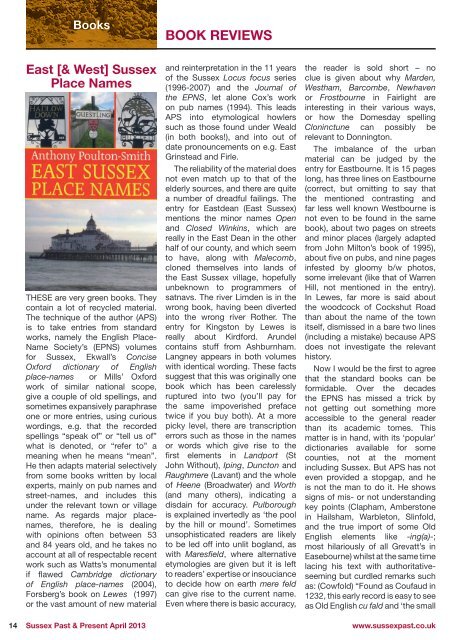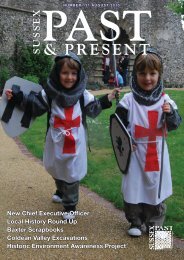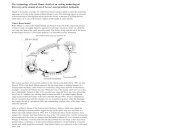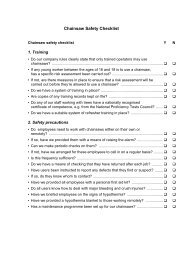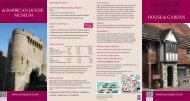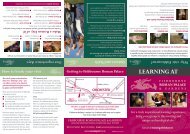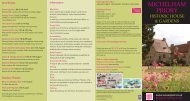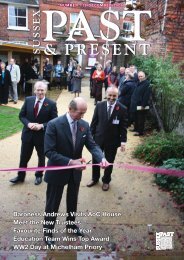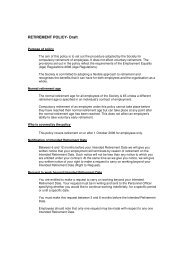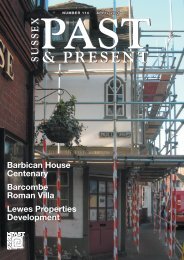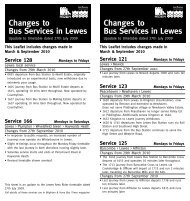April 2013 (issue 129) - The Sussex Archaeological Society
April 2013 (issue 129) - The Sussex Archaeological Society
April 2013 (issue 129) - The Sussex Archaeological Society
- No tags were found...
You also want an ePaper? Increase the reach of your titles
YUMPU automatically turns print PDFs into web optimized ePapers that Google loves.
Books<br />
BOOK REVIEWS<br />
BOOK REVIEWS<br />
Books<br />
East [& West] <strong>Sussex</strong><br />
Place Names<br />
THESE are very green books. <strong>The</strong>y<br />
contain a lot of recycled material.<br />
<strong>The</strong> technique of the author (APS)<br />
is to take entries from standard<br />
works, namely the English Place-<br />
Name <strong>Society</strong>’s (EPNS) volumes<br />
for <strong>Sussex</strong>, Ekwall’s Concise<br />
Oxford dictionary of English<br />
place-names or Mills’ Oxford<br />
work of similar national scope,<br />
give a couple of old spellings, and<br />
sometimes expansively paraphrase<br />
one or more entries, using curious<br />
wordings, e.g. that the recorded<br />
spellings “speak of” or “tell us of”<br />
what is denoted, or “refer to” a<br />
meaning when he means “mean”.<br />
He then adapts material selectively<br />
from some books written by local<br />
experts, mainly on pub names and<br />
street-names, and includes this<br />
under the relevant town or village<br />
name. As regards major placenames,<br />
therefore, he is dealing<br />
with opinions often between 53<br />
and 84 years old, and he takes no<br />
account at all of respectable recent<br />
work such as Watts’s monumental<br />
if flawed Cambridge dictionary<br />
of English place-names (2004),<br />
Forsberg’s book on Lewes (1997)<br />
or the vast amount of new material<br />
and reinterpretation in the 11 years<br />
of the <strong>Sussex</strong> Locus focus series<br />
(1996-2007) and the Journal of<br />
the EPNS, let alone Cox’s work<br />
on pub names (1994). This leads<br />
APS into etymological howlers<br />
such as those found under Weald<br />
(in both books!), and into out of<br />
date pronouncements on e.g. East<br />
Grinstead and Firle.<br />
<strong>The</strong> reliability of the material does<br />
not even match up to that of the<br />
elderly sources, and there are quite<br />
a number of dreadful failings. <strong>The</strong><br />
entry for Eastdean (East <strong>Sussex</strong>)<br />
mentions the minor names Open<br />
and Closed Winkins, which are<br />
really in the East Dean in the other<br />
half of our county, and which seem<br />
to have, along with Malecomb,<br />
cloned themselves into lands of<br />
the East <strong>Sussex</strong> village, hopefully<br />
unbeknown to programmers of<br />
satnavs. <strong>The</strong> river Limden is in the<br />
wrong book, having been diverted<br />
into the wrong river Rother. <strong>The</strong><br />
entry for Kingston by Lewes is<br />
really about Kirdford. Arundel<br />
contains stuff from Ashburnham.<br />
Langney appears in both volumes<br />
with identical wording. <strong>The</strong>se facts<br />
suggest that this was originally one<br />
book which has been carelessly<br />
ruptured into two (you’ll pay for<br />
the same impoverished preface<br />
twice if you buy both). At a more<br />
picky level, there are transcription<br />
errors such as those in the names<br />
or words which give rise to the<br />
first elements in Landport (St<br />
John Without), Iping, Duncton and<br />
Raughmere (Lavant) and the whole<br />
of Heene (Broadwater) and Worth<br />
(and many others), indicating a<br />
disdain for accuracy. Pulborough<br />
is explained invertedly as ‘the pool<br />
by the hill or mound’. Sometimes<br />
unsophisticated readers are likely<br />
to be led off into unlit bogland, as<br />
with Maresfield, where alternative<br />
etymologies are given but it is left<br />
to readers’ expertise or insouciance<br />
to decide how on earth mere feld<br />
can give rise to the current name.<br />
Even where there is basic accuracy,<br />
the reader is sold short – no<br />
clue is given about why Marden,<br />
Westham, Barcombe, Newhaven<br />
or Frostbourne in Fairlight are<br />
interesting in their various ways,<br />
or how the Domesday spelling<br />
Cloninctune can possibly be<br />
relevant to Donnington.<br />
<strong>The</strong> imbalance of the urban<br />
material can be judged by the<br />
entry for Eastbourne. It is 15 pages<br />
long, has three lines on Eastbourne<br />
(correct, but omitting to say that<br />
the mentioned contrasting and<br />
far less well known Westbourne is<br />
not even to be found in the same<br />
book), about two pages on streets<br />
and minor places (largely adapted<br />
from John Milton’s book of 1995),<br />
about five on pubs, and nine pages<br />
infested by gloomy b/w photos,<br />
some irrelevant (like that of Warren<br />
Hill, not mentioned in the entry).<br />
In Lewes, far more is said about<br />
the woodcock of Cockshut Road<br />
than about the name of the town<br />
itself, dismissed in a bare two lines<br />
(including a mistake) because APS<br />
does not investigate the relevant<br />
history.<br />
Now I would be the first to agree<br />
that the standard books can be<br />
formidable. Over the decades<br />
the EPNS has missed a trick by<br />
not getting out something more<br />
accessible to the general reader<br />
than its academic tomes. This<br />
matter is in hand, with its ‘popular’<br />
dictionaries available for some<br />
counties, not at the moment<br />
including <strong>Sussex</strong>. But APS has not<br />
even provided a stopgap, and he<br />
is not the man to do it. He shows<br />
signs of mis- or not understanding<br />
key points (Clapham, Amberstone<br />
in Hailsham, Warbleton, Slinfold,<br />
and the true import of some Old<br />
English elements like -ing(a)-;<br />
most hilariously of all Grevatt’s in<br />
Easebourne) whilst at the same time<br />
lacing his text with authoritativeseeming<br />
but curdled remarks such<br />
as: (Cowfold) “Found as Coufaud in<br />
1232, this early record is easy to see<br />
as Old English cu fald and ‘the small<br />
enclosure for cows’”, and a bizarre<br />
one on the supposedly posthumous<br />
naming of Etchingham.<br />
<strong>The</strong> reviewer would recommend<br />
the out of print and by no means<br />
faultless single-volume popular<br />
book by Judith Glover (Batsford,<br />
especially the unextended second<br />
edition of 1986) as much superior<br />
to these pretty-covered but<br />
pretty depressing books, which<br />
are regrettably already available<br />
on Kindle and in National Trust<br />
bookshops. Find a way of recycling<br />
your copies if you already have<br />
them.<br />
Richard Coates<br />
By Anthony Poulton-Smith, 2012.<br />
East <strong>Sussex</strong> Place Names and West<br />
<strong>Sussex</strong> Place Names. DB Publishing.<br />
ISBN 978-1-78091-016-1 (191 pp)<br />
and 978-1-78091-017-8 (189 pp).<br />
Paperback. £9.99 each.<br />
<strong>Sussex</strong> Coast<br />
Through Time<br />
THERE are many books of<br />
photographs of the beautiful<br />
<strong>Sussex</strong> coastline, but Douglas<br />
d’Enno in his book <strong>Sussex</strong> Coast<br />
Through Time is more concerned<br />
to focus on the social changes<br />
which have occurred over the last<br />
150 years on or near the shoreline.<br />
He does this by presenting us with<br />
a series of contrasting images<br />
beginning with Camber Sands in<br />
the east, and ending 90 miles away<br />
in Chichester Harbour using a<br />
mixture of paintings, postcards and<br />
photographs dating from the latter<br />
part of the 19th century.<br />
An early pairing is labelled ‘Rye<br />
Harbour Postmaster’ and shows<br />
Mr A G Hedgler looking out of the<br />
front door of the Post Office in the<br />
1920s, compared with the current<br />
use as residences of both the<br />
Post Office and the neighbouring<br />
Methodist Chapel. Similar<br />
contrasts are shown by those of<br />
central Shoreham, whilst those of<br />
East Brighton show what Brighton<br />
people are missing whilst the Black<br />
Rock site still awaits development.<br />
In researching the book the author<br />
made use of many local experts<br />
who shared their knowledge of<br />
building use and offered glimpses<br />
into the lives of the people in the<br />
images. A 1939 postcard of the<br />
Pagham Riviera Lido Holiday Club<br />
was sent by someone who had<br />
to leave because of evacuation. ‘I<br />
wish Hitler at the bottom of the sea’<br />
the sender cries.<br />
It is noteworthy that many of<br />
the photographs have never been<br />
published before in a book, and<br />
this distinguishes <strong>Sussex</strong> Coast<br />
Through Time from other volumes<br />
of before and after images. It<br />
should be of interest to both general<br />
readers and social historians.<br />
Maria Gardiner<br />
By Douglas d’Enno, 2012.<br />
Amberley Publishing. ISBN:<br />
978-1-4456-0546-3.<br />
Paperback, 96pages, £14.99.<br />
Lewes<br />
Through Time<br />
IN respect of the photographic<br />
heritage of the town and its<br />
accessibility to researchers and<br />
other interested parties, Lewes<br />
is fortunate – and doubly so.<br />
Firstly, there survives a friendly<br />
photographic business (with a<br />
magnificent archive) that has<br />
been active in and around the<br />
town since the 1850s. Secondly,<br />
the Lewes area is home to a<br />
number of indefatigable collectors<br />
of postcards of local views who<br />
recognise the potential value of<br />
their respective collections to the<br />
social and local historian. One of<br />
the infatigables has selected some<br />
treasures from his collection (2,000<br />
strong – and counting, I am reliably<br />
informed) and joined with Amberley<br />
Publishing to present this latest title<br />
in the ‘Through Time’ series.<br />
<strong>The</strong> conjoining of ‘then’ and<br />
‘now’ images is well-tried and<br />
tested (though this book does not<br />
stick rigidly to the familiar formulaic<br />
format), and results in a graphic<br />
presentation of the changes in<br />
townscape, traders and traffic over<br />
the last 100 years or so. Changes<br />
in businesses and road use are<br />
a given; alterations in the fabric<br />
of the townscape, also, are to be<br />
expected, but the amount of change<br />
can vary from town to town.<br />
On the whole, and here I disagree<br />
with the tag to the photograph<br />
on page 2, Lewes has not been<br />
decimated, whether ‘in the name of<br />
progress’ or in the name of anything<br />
else. Change occurs – slum<br />
clearance in the 1930s (Westgate<br />
Street, page 48; lower North Street,<br />
page 70); war damage (Stag Hotel,<br />
North Street, page 68); post-war<br />
concern with inter alia traffic flow<br />
and car parking (Malling Street,<br />
pages 9, 11-13; Cliffe crossroads,<br />
page 22; Little East Street, page<br />
69). And, always there will be a<br />
destructive fire or two or three<br />
or four – Lewes Sanitary Steam<br />
Laundry, now housing (page 5);<br />
<strong>The</strong> Bear Hotel, rebuilt as JCH<br />
Martin and now Argos (pages 27-<br />
8); Smith’s, now Mimi and A & A<br />
Nails (page 41); Dusart’s, now A &<br />
Y Cumming and Lewesiana (page<br />
45).<br />
But, the impression gained from<br />
reading and viewing Bob Cairns’<br />
informed and informative ‘through<br />
time’ journey around Malling, Cliffe,<br />
Lewes and Southover, is that much<br />
of the townscape fabric recorded<br />
in the early-20th century has<br />
survived. Further to this, some of<br />
the buildings that have appeared in<br />
the intervening years – the art deco<br />
of Argos, the restrained balconied<br />
statement of Mimi and A&A Nails,<br />
for example (both new builds on<br />
fire sites, I note) – are undoubtedly<br />
adornments to an essentially 19thcentury<br />
and earlier townscape.<br />
John Bleach<br />
By Bob Cairns, 2012.<br />
Amberley Publishing.<br />
ISBN: 978-1-84868-807-0.<br />
Paperback. £14.99.<br />
14 <strong>Sussex</strong> Past & Present <strong>April</strong> <strong>2013</strong><br />
www.sussexpast.co.uk www.sussexpast.co.uk <strong>Sussex</strong> Past & Present <strong>April</strong> <strong>2013</strong> 15


